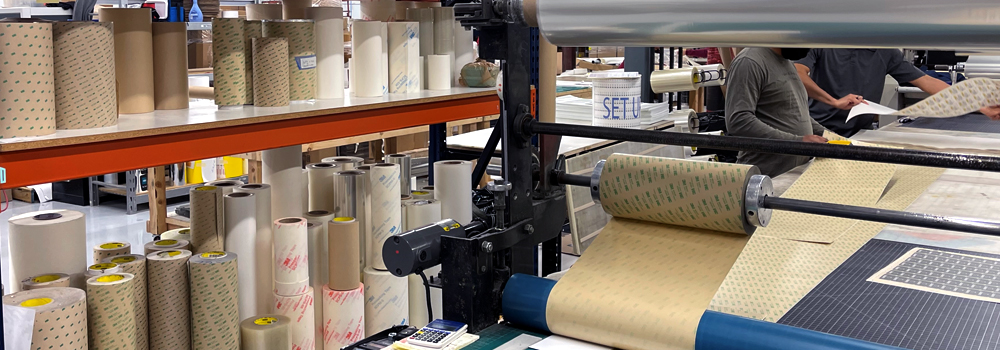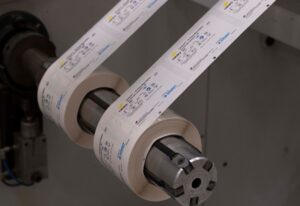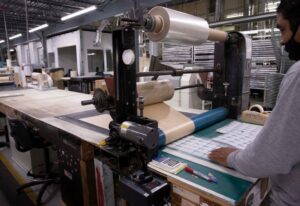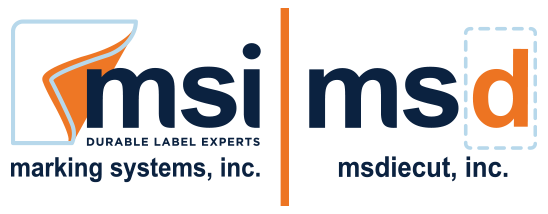Label Lamination

Let’s talk lamination! It’s a big part of our business here at Marking Systems, and an important service for our customers. As we’re fond of saying, your product’s label is your first impression. And you know the old adage about first impressions — you never get a second chance to make one. If your label is scratched, torn or otherwise damaged, your great first impression can go right down the tubes.
That’s why it’s important to laminate your labels. Lamination adds a layer of protection to your label, guarding against weather, temperature and other things like scratches, dirt and tears.
But protection isn’t a laminate’s only function. It can also add to the appearance and functionality of your label, depending on the finish you choose, like gloss, matte or another decorative finish.
We use several common and specialty laminates, depending on the type of label and its ultimate use.
Common laminates

The most common laminates we use are polyester, thermal polyester, velvet polycarbonate and vinyl. Here are some quick facts about these common laminates.
Polyester: Most common type of laminate in the durable product label industry.
- Excellent heat and chemical resistance
- UV version for 5+ years outdoors
- Comes in either a clear gloss or a matte finish
Thermal Polyester: Laminate makes any base material thermal printable
- Labels can be printed by the OEM in their facility with a thermal printer
- Typical thickness: .001
- Comes in clear gloss and matte finish. Matte finish is excellent for writing variable data with either a pen or Sharpie
- Allows the OEM to print serial numbers, bar codes and manufacturing date codes on their product labels at the time of the shipment
Velvet Polycarbonate: Typically used as a decorative laminate to give vinyl or polyester the same appearance as polycarbonate.
- Decorative and durable just like standard polycarbonate
- Typical thickness: .003, .005 and .065
- Velvet finish
- Can be used as a “cost reduction” alternative to .010 velvet polycarbonate
Vinyl: Used in situations that require scratch-resistant and/or conformable product label printing.
- Highly conformable for odd applications
- Typical thickness: .002, .004, .006 and .008
- High-gloss finish
Specialty laminates
Some projects need specialized labels. Here’s a rundown of the specialty laminates we use.

Markwrite Polyester: Used with dry-erase markers.
- Clear gloss finish
- .001 thickness
Egrip Elastomer: Anti-skid silicone elastomer designed to prevent products from slipping or sliding.
- Thickness: .014
- Clear finish with a suction grip texture
3M1150 Anti-graffiti film: As a protective product label overlay, this film is a barrier to staining by many types of graffiti (spray paint, permanent markers, lipstick, etc.) It can be cleaned using selected solvent wipes.
- .007 thickness
- Clear gloss finish
Laminating Pouches: Heat sealed and cold sealed.
- Thickness: .003, .005, .007, .010
- Comes in clear gloss and matte finish
- Laminates both sides. Used to encapsulate badges, cards or tags.
Screened and Liquid Clear Coat: Superior to standard polyester laminate in outdoor applications because of the UV resistance. The Clear Coat is scratch resistant, chemical resistant and UV rated for 7+ years.
Nitrogen-Cured UV Textured Hard Coat Clear: Designed for use with Graphic Overlays with LED and LCD displays. In many cases, the designer of the overlay would like the LCD displays to be “water clear” while the remainder of the overlay has a “velvet texture” finish. This can be achieved by using product label printing that utilizes a UV clear coat that is cured by using a nitrogen curing dryer. Nitrogen-Cured UV Textured Hard Coat Clear is as durable as the factory velvet finish.
Need help with your product lamination project? Call MSI at 972-895-3433, and our product label printing experts will be happy to help.
